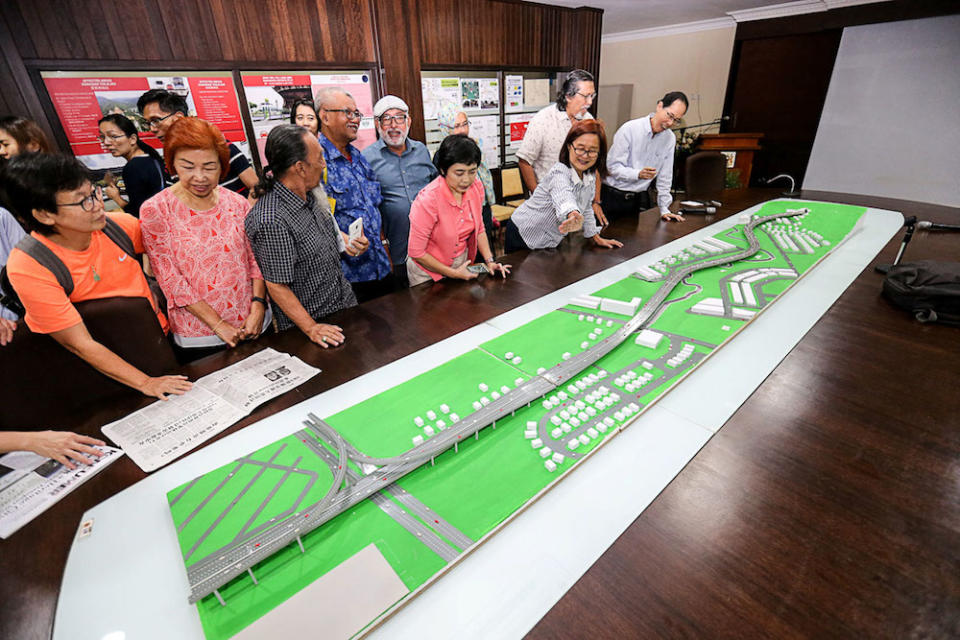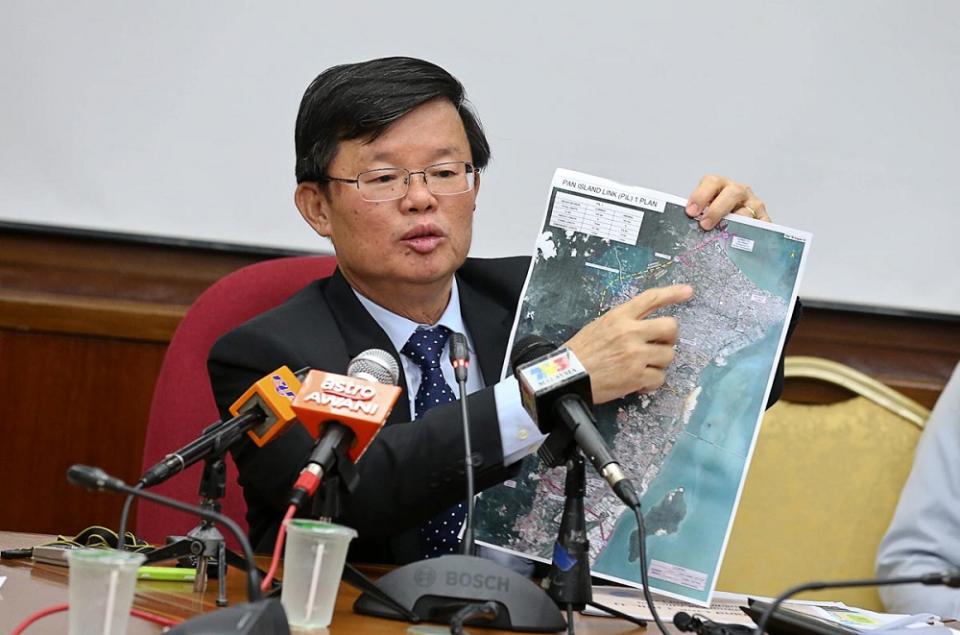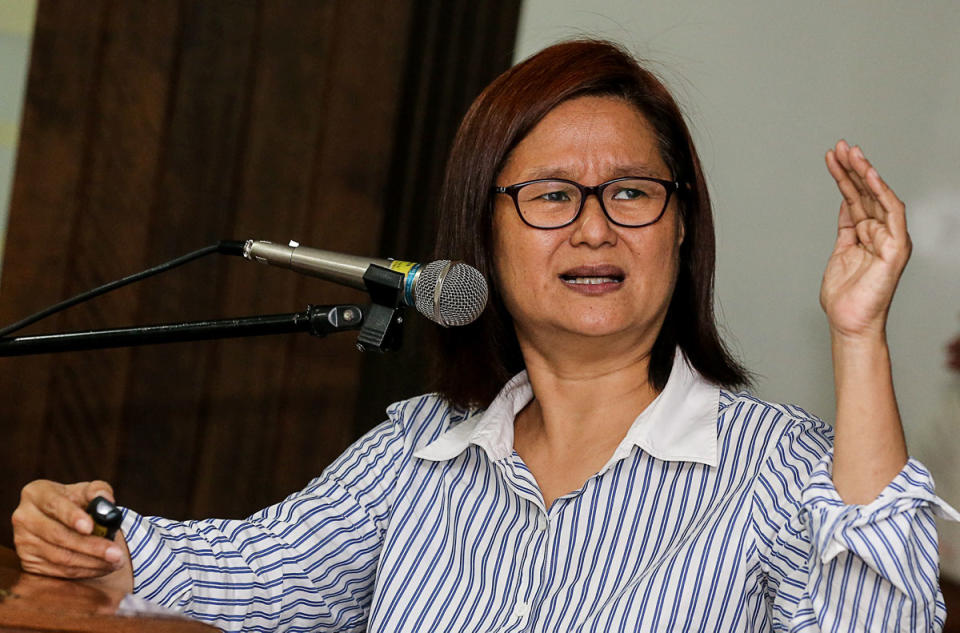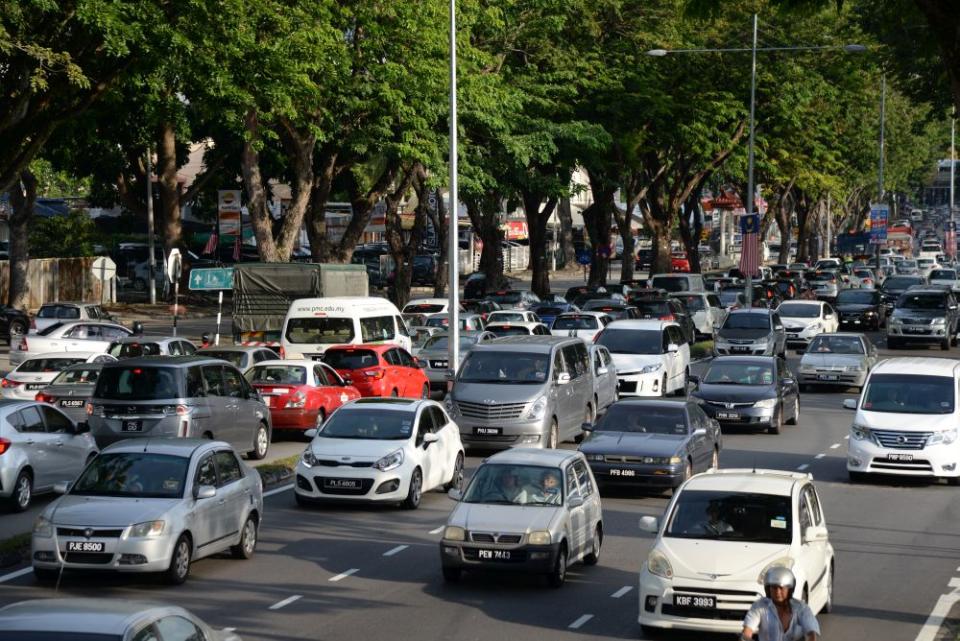So what exactly is the Penang Transport Master Plan and how is it being funded?

GEORGE TOWN, June 27 — The controversial Penang Transport Master Plan (PTMP) started out as a concept plan to arrest traffic and transportation issues in Penang back in 2009, just a year after Pakatan Rakyat (now Pakatan Harapan) took over Penang’s administration.
The state government established the 20-member Penang Transport Council (PTC) on July 10 in 2009 to come up with a transport master plan for the state.
The then-Penang Chief Minister Lim Guan Eng reportedly said the transport master plan will include the construction of better roads and highways, proper traffic management through a one-way street system and Intelligent Transport System.
In April 2011, the Penang state government and NCIA (Northern Corridor Implementation Agency) appointed AJC Planning Consultants Sdn Bhd (AJC) in association with Halcrow Consultants Sdn Bhd (Halcrow) and supported by Singapore Cruise Centre (SCC) to carry out the Penang Transport Master Plan Study.
In October 2012, Halcrow submitted four reports: Public Transport Approach, Highway-based Strategies, Accessibility Report and Institutional Reforms.
The Public Transport Approach proposed a transport network that included the long- and medium-term setting up of hubs and park and ride stations, along with a wider bus service network, bus rapid transit (BRT), trams and light rail transit (LRT).
The Highway-based Strategies included road hierarchy studies, road improvement network, widening of roads, and key projects to support and complement the Public Transport Approach.
The Accessibility Report supports the need for better accessibility to public transport and guidelines to ensure accessibility for all in both urban and rural areas.
The Institutional Reforms report proposed transport policies and directions for the state that included setting up a high-level committee to implement transport strategies and policies.
On August 14, 2015, Lim announced the appointment of SRS Consortium as the project delivery partner (PDP) for the PTMP which was then estimated to cost about RM27 billion.
SRS Consortium comprised Gamuda Berhad (60 per cent), Penang-based Loh Phoy Yen Holdings Sdn Bhd (20 per cent), and Ideal Property Development Sdn Bhd (20 per cent).
Fast forward to 2019 and components of the PTMP will be rolled out soon. Two of these — the Pan Island Link 1 (PIL1) and Penang South Reclamation (PSR) — have been attacked and criticised by civil society at large.
So, what actually makes up the PTMP?
While public forums, town hall sessions and dialogues have been held and — according to the state’s official PTMP website — about 19,021 people engaged, many Penangites remain unclear about the mega-project.
Here is a look at the PTMP and the issues surrounding it:

1. A transport blueprint
The PTMP was introduced as a “comprehensive, efficient and well-connected transport strategy” to put in place an integrated and modern transport framework for the state that includes public, private, land and sea transportation systems.
It hoped to achieve a public private transport model share of 40:60 by the year 2030 and so, it proposed an LRT, monorail, BRT, trams, e-hailing, ferry and water taxies.
It also proposed a major highway, PIL1, and two other shorter highways, PIL2 and PIL2a.
The proposed RM6.3 billion three paired roads and undersea tunnel, to be implemented by a different PDP, Consortium Zenith, were also part of the plan.
However, the state wanted to implement PIL1 and the Bayan Lepas-George Town LRT line (BL LRT) first.
PIL1 is a 19.5-km highway that is estimated to cost RM7.5 billion.
It will consist of 7.6 km of viaduct sections, four tunnel sections totalling 10.1 km in length and embankment sections totalling 1.8 km.
PIL1, which links Gurney Drive to Bayan Lepas, will have six interchanges linking all major hubs.
It will integrate with the north coastal paired road, Gurney Drive paired road, Air Itam and Tun Dr Lim Chong Eu Expressway Bypass, first and second Penang bridge, the proposed undersea tunnel and Tun Dr Lim Chong Eu Expressway.
In one of the many press conferences on the PTMP and PIL1, current Penang Chief Minister Chow Kon Yeow said PIL1 will affect a total 226 buildings, out of which 62 are residential, 30 commercial, four religious places, 48 minor structures and 82 squatters.
The Environmental Impact Assessment (EIA) report for PIL1 was approved by the Department of Environment (DoE) on April 10 this year, with 56 conditions despite objections by civil society and those affected.
“With this EIA approval, we can move on to obtaining detailed design, land acquisition and appointing contractors for the project through open tender,” Chow said when announcing the approval.
The BL LRT is estimated to cost RM8.4 billion and it will stretch from Bayan Lepas to George Town and will also be linked to Penang South Reclamation (PSR) once the islands are reclaimed.
The rail line is estimated to cover 29.5 kilometres and will have 27 stations linking the Penang International Airport in Bayan Lepas with Komtar in George Town.
The state is still awaiting conditional approval by the Transport Ministry for the BL LRT.
Apart from these two priority projects, also proposed in the PMTP are trams around George Town, a monorail to link Tanjung Tokong to Komtar, a monorail to link Ayer Itam to Komtar and a monorail to link Raja Uda in Butterworth to Bukit Mertajam on the mainland.
There is also a proposed LRT line linking George Town to Butterworth and a Permatang Tinggi to Batu Kawan BRT on the mainland.
Finally, Pan Island Link 2 (PIL2) and PIL2a, which are smaller highways, were proposed to link Relau to Island C of the PSR and the Penang International Airport (PIA) to Island A of the PSR respectively.
All of these other projects are under phase two of the PTMP while PIL1 and BL LRT are under phase one.

2. Who’s paying for it?
When the PTMP was proposed in 2015, it was estimated to cost RM27 billion but now the cost has ballooned to around RM46 billion.
This does not include the RM6.3 billion three paired roads and undersea tunnel component, which will be implemented separately by Zenith Consortium.
When the PTMP was first proposed, Penang was an Opposition party-led state so it could not request for funding from the then Barisan Nasional (BN) federal government.
This meant the state had to seek its own funding for the PTMP, particularly the LRT and PIL1, both of which are estimated to cost a total RM15.9 billion.
This was where the PSR came in.
The creation of three islands off the southern coast of the main island was the state’s answer to getting funding for the PTMP.
It will cost SRS about RM11 billion to reclaim the three islands — A, B and C — which will make available a total 4,500 acres of lands.
According to Gamuda earlier this year, Island A will be an Industrial park where lots will be sold to investors to raise funds for the PTMP.
Island B will be for high-end support services for the industrial park, such as financial services, business services and also tourism, while Island C will be for the creation of newer tourism products and also house some residential properties.
In an April 16 article, The Star daily estimated that at a price of RM200 psf for the industrial park on island A, the state could raise more than RM70 billion which could more than cover the cost of the PTMP.
However, there is still an issue with funding as the cost of reclamation is RM11 billion and without initial funding to reclaim the land first, there will not be any land for the state to sell.
Back in 2017, the state announced its intention to apply for a bridging loan of RM1 billion from China once the necessary approvals for PSR was obtained.
Now that Penang is no longer an Opposition state, Chow is hoping to obtain funding, in terms of a loan, from the federal government.
The EIA for the PSR was on public display twice, once in 2017 and after it was rejected by the DoE last year, a revised EIA was submitted in February this year.
The revised EIA was on public display between April 29 and May 28 this year.
While the National Physical Planning Council (NPPC) has given the nod to the PSR in April, it also set out 18 conditions for the state to adhere to before implementing the project and the green light is also subject to other required approvals.

3. Controversies
As with any mega projects in Penang, there was criticism and objections by non-governmental organisations (NGOs) as well as the state government’s political foes.
Back in 2002, a RM1.03 billion Penang Outer Ring Road (PORR) project was announced by the then-BN state government.
PORR was an 18-kilometre toll highway linking Tanjong Tokong to Penang Bridge, a highway that sounds almost like that of the current PIL1 except that it had a different route.
There was a huge outcry and objection against PORR as it involved massive land acquisition that would have resulted in the relocation of hundreds of Penangites along the whole route.
Even Chow, who was the Tanjung MP at that time and on the Opposition bench, had objected against the tolled highway.
“However, we also demand that the Works Minister also considers a total review of the effectiveness of the PORR in solving traffic problems and the privatisation of the project to Peninsular Metro-Works. We are disappointed that the government has still not considered whether the PORR could be effective in resolving traffic problems,” Chow wrote in a statement on June 3 in 2002.
This is the very same argument that Penang NGOs made against PIL1.
The late Penang Consumers Association (CAP) president SM Mohamed Idris had vehemently called for the PORR to be cancelled back in 2002 and when PIL1 was proposed, he had also called for it to be cancelled.
Penang Forum, a loose coalition of Penang NGOs that includes CAP, had also called for PIL1 to be scrapped and for the PTMP to be reviewed.
The groups questioned the effectiveness of PIL1 in resolving Penang’s worsening traffic congestion and proposed that the state government followed the original proposal by Halcrow in 2012 instead.
They pointed out that Halcrow had proposed the Public Transport Approach, which focused more on implementing a public transport network and not build a RM7.5 billion highway.
There were also safety and environmental concerns about blasting works under Penang Hill and Paya Terubong to create tunnels for the highway.
Penang Forum member Lim Gaik Siang, who is also an engineer, said the drilling works for the tunnel was planned near fault lines in the vicinity of the Air Itam Dam.
“This could affect the dam and if the dam bursts, it will bring down 2.5 million litres of water on houses below, either in Air Itam or the other side, in Jesselton area, depending on where it will crack,” she said during a talk organised by Penang Forum on PIL1 and PTMP.
PIL1 was not the only project that received such an adverse reaction, PSR too raised much concern and objections, especially by the fishing communities along the southern coast.
Penang Forum’s Khoo Salma started an online petition “Save Penang! Reject the 3-Islands Reclamation” addressed to the prime minister and as at June 27, it has garnered over 41,000 signatures.
In May, a total of 45 NGOs joined Penang Forum in calling for the PSR to be scrapped entirely, as it was believed that it could negatively impact the livelihood of 5,000 fishermen and their families.
They claimed the destruction of the state’s natural coast will also affect Penang’s food security in terms of seafood caught from the seas off Penang.
The Penang state government responded by stating that more than half the affected fishermen had agreed to the PSR.
Agriculture, agro-based industries, rural development and health committee chairman Dr Afif Bahardin told the legislative assembly this year that a majority of the fishermen wanted compensation.
He also said mitigating measures will be implemented to ensure fishermen can continue going out to sea.
“All fishing activities will be maintained so we will be getting feedback from the fishermen on building jetties for them after the islands are reclaimed,” he told the august House.

4. Three paired roads and undersea tunnel
This project will be implemented separately from PIL1, PSR and BL LRT under the PTMP as it is by Consortium Zenith Construction (CZC), a different PDP.
CZC, then Zenith-BUCG, was appointed as PDP first in 2013 and the project was subsequently included in the overall PTMP.
The feasibility studies for the undersea tunnel are still pending approval, but the EIA for all three paired roads have already been approved.
The first paired road project will connect Tun Dr Lim Chong Eu Expressway to Air Itam, the second is the Northern Coast Paired Road (NCPR) which connects Gurney Drive to Tanjung Bungah and from there to Teluk Bahang, while the third will connect Gurney Drive to Tun Dr Lim Chong Eu Expressway.
These are major roads that will involve land acquisitions, an underground tunnel for the third package, and some portions cross over hills behind residential areas.
Work on the first paired road is expected to start on September 1 and the chief minister has said that the state will be signing an agreement with CZC soon for the project to start.
Work on the undersea tunnel is only expected to start in 2023 after the three paired roads are completed.
Unlike PIL1 and BL LRT which will depend on PSR to fund it, this project will be funded by a land swap deal.
A total 44.5 hectares of reclaimed land was identified to be swapped with CZC for construction work on the undersea tunnel and three paired roads.
The 20.2-hectare piece of reclaimed land in Bandar Tanjong Pinang is part of the land swap payment under part two of the project, which is the construction works proper.
The Penang state government has already exchanged land worth RM208 million under part one of the project, which is for the feasibility studies and detailed designs (FSDD) of the three paired roads component of the project.
This project was highly criticised and even investigated by the Malaysian Anti-Corruption Commission (MACC) after political leaders claimed there were corrupt practices involved.
MACC later cleared CZC of any corrupt practices.
The PTMP was planned as a transport blueprint to resolve Penang’s traffic woes by 2030 and despite an initial timeline that suggested it will start in 2016, actual physical work on any of its components is yet to start.
It is still very much in the planning stage and PIL1, since it was only recently approved, is now in the detailed design and land acquisition stage, while SRS is yet to appoint contractors for the project.
Chow has said in an interview with Malay Mail that he hoped to see PMTP projects being physically implemented by the middle of his term, which is by late 2020 or 2021.
He had hoped that the federal government would take over the LRT project and relieve the state of the financial burden of building it but since that is not forthcoming, he said PSR must be implemented to raise funds.
This means the state is still short of an RM1 billion bridging fund to kick off the project and Chow is determined to get a loan once PSR gets the necessary approvals.
It also means that the state will go ahead with the PSR, once it is approved, despite objections as it was a crucial component of the PTMP, for without it, there will not be enough money for the other components of the whole plan.
Related Articles Penang transport plan uses competitive open RFP — Joshua Woo NGOs, experts free from accountability? — Timothy Tye and Joshua Woo Penang CM dismisses call to extend public display of reclamation EIA report


